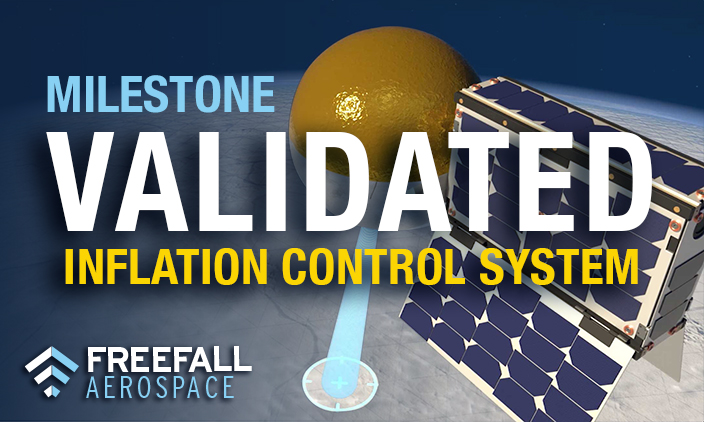FreeFall Aerospace Inflation Control System Validated for Spaceflight
Ready for lift-off, the novel inflatable antenna system developed by FreeFall Aerospace is validated and ready for space! In partnership with the University of Arizona (UA) and Northrop Grumman, on July 1, 2021, FreeFall successfully conducted thermal vacuum tests of the inflation control system. This test validates the performance in simulated space, including the possible impact of orbital debris and micro-meteoroids. The inflation control system is part of the new inflatable Cubesat antenna that will provide Big Data from Small Spacecraft. This antenna will be demonstrated in space in April 2022.
This novel inflatable antenna system developed by Tucson technology company FreeFall Aerospace, in conjunction with the University of Arizona, is a critical component of CatSat, one of eight research satellites to be launched aboard a NASA mission in April 2022. The satellites selected under NASA’s CubeSat Launch Initiative will perform technology demonstrations, conduct scientific investigations, and provide educational benefits.

FreeFall’s antenna system utilizes an ultra-lightweight inflatable structure that can be stowed in a very small volume. Once it is deployed in orbit, it provides a large aperture, high-gain antenna. This approach will dramatically increase the total data return and overall effectiveness of Cubesats and other small satellites. The Principal Investigator of CatSat is Dr. Chris Walker, professor of Astronomy at UA and co-founder of FreeFall Aerospace.
CatSat is a 6U CubeSat built by GOMspace of Denmark that is now being integrated and tested by UA students from various departments, including Aerospace and Mechanical Engineering, Astronomy, Computer Science, and Electrical and Computer Engineering. It allows undergraduate and graduate students to get hands-on experience developing and operating a space mission and involves more than a dozen UA students spread across campus.
Once in orbit, the FreeFall antenna will deploy using compressed gas to inflate a 0.5-meter diameter Mylar spherical reflector incorporating a proprietary feed system. Under contract from FreeFall Aerospace, Picocyl LLC (Golden, CO) developed and built the gas delivery unit, including specialized gas canisters. This unit was integrated with the deployment and control system.
The Catsat inflatable antenna will attempt transmitting high definition earth imagery in near real-time using a 6.1 m ground station antenna at Biosphere2. A second whip antenna will also be used to probe how the ionosphere structure varies at different times of the day. Catsat shall orbit the earth approximately 15 times every 24 hours.
“This validation of our inflation control system is a crucial step for FreeFall Aerospace, the University of Arizona, and Tucson’s developing space ecosystem. We’re looking forward to making this capability available for commercial, scientific, and government space missions.”

Validation of FreeFall Aerospace’s inflation control system – Photo courtesy of Northrop Grumman





Leave A Comment